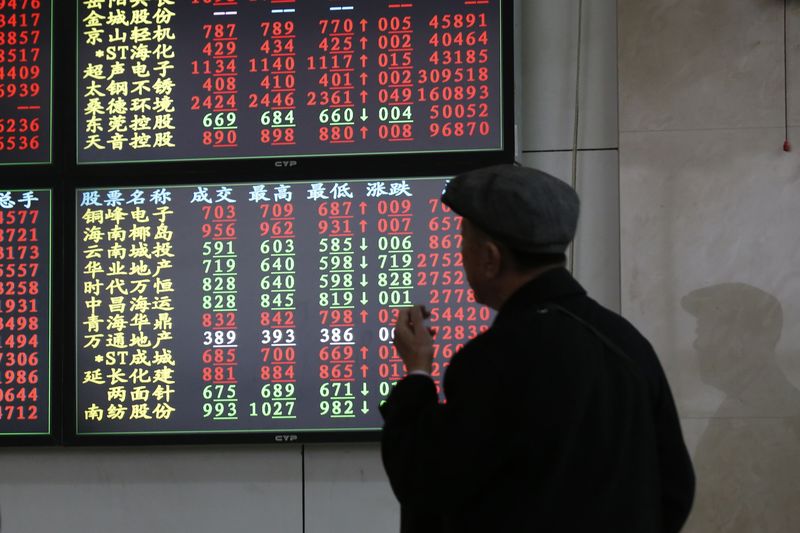Broadcom named strategic vendor for Walmart virtualization solutions
* Asian stock markets: https://tmsnrt.rs/2zpUAr4
* Tracking the coronavirus: https://tmsnrt.rs/3aIRuz7
* Dollar recoups ground on the yen
* Australian shares surge, Nikkei flat
* Oil market faces falling demand, more Saudi supply
By Stanley White and Kane Wu
TOKYO/HONG KONG, March 17 (Reuters) - Asian shares held
their ground on Tuesday in a volatile session following one of
Wall Street's biggest one-day routs in history as headlines
about the coronavirus outbreak and its global economic impact
whiplashed investor sentiment.
Financial markets cratered on Monday with the S&P 500 .SPX
tumbling 12%, its biggest drop since "Black Monday" three
decades ago, as a series of emergency central bank rate cuts
globally only added to the recent sense of investor panic.
Australian shares .AXJO closed 5.9% higher, to record the
biggest daily percentage gain since Oct 2008, following a nearly
10% plunge on Monday. But few investors are feeling confident
and uncertainty prevails.
MSCI's broadest index of Asia-Pacific shares outside Japan
.MIAPJ0000PUS was flat, as was Japan's Nikkei stock index
.N225 which traded either side of even through a bumpy day.
South Korea's KOSPI .KS11 was down 2.4%.
Futures trade pointed to a positive open in U.S. and
European markets. The S&P 500 e-minis ESc1 , were up 3.8% at
their upper limit of 2,508.5.
In Europe, the pan-region Euro Stoxx 50 futures STXEc1
were up 1.8% at 2,463, German DAX futures FDXc1 were up 1.7%
at 8,873.5 and FTSE futures FFIc1 were up 2.2% at 5,232.5.
"The move in U.S. stock futures prompted some buying of
battered down shares and lifted dollar/yen," said Junichi
Ishikawa, senior FX strategist at IG Securities in Tokyo.
"The focus is shifting to the fiscal response to the virus.
We're locked in a pattern where markets bounce and then resume
falling."
Some $2.69 trillion in market value was wiped from the S&P
500 on Monday as it suffered its third-largest daily percentage
decline on record. Over the past 18 days, the benchmark index
has lost $8.28 trillion.
Gold, which is normally bought as a safe-haven, extended
declines on Tuesday as some investors chose to sell whatever
they could to keep their money in cash.
Oil futures rebounded in Asia, but downside risks remain due
to an expected slump in global energy demand and Saudi Arabia's
plans to increase crude output to expand its market share.
The U.S. Federal Reserve stunned investors with another
emergency rate cut on Sunday, prompting other central banks to
ease policy in the biggest coordinated response since the global
financial crisis more than a decade ago.
Investors, however, are worried that central banks may have
spent all their ammunition and that more draconian restrictions
on personal movement are necessary to contain the global
coronavirus outbreak.
Group of Seven finance ministers are expected to hold a call
on Tuesday night -- though markets are wanting to see public
health progress as well as huge fiscal stimulus.
"I think the priorities of the governments around the world
will probably move away from economic growth towards containing
the virus," said Jim McCafferty, Nomura's joint head of APAC
equity research.
"Safety of national citizens might become a bigger priority.
But with that they want to keep the economies in a working
situation."
Traders are also looking to data due later on Tuesday, which
is forecast to show German investor sentiment tumbled in March.
The United States will release retail sales and industrial
production for February, which is unlikely to reflect the impact
of the coronavirus.
Some investors say markets will not settle unless the U.S.
government announces a big fiscal spending package to match the
Fed's bold actions to slash rates and keep credit markets
functioning.
Others say liquidity in some financial markets is starting
to fall because there's such a high degree of uncertainty,
meaning even some traditional safe-havens may not be that safe.
Spot gold XAU= fell 0.93% to $1,497.60 per ounce. GOL/
In the currency market, the dollar rose 0.5% to 106.40 yen
JPY=EBS , recovering slightly from a 2% decline from the
previous session as the Fed's rate rippled through financial
markets.
U.S. crude CLc1 ticked up 4.25% to $29.92 a barrel. Brent
crude LCOc1 also rose 2.40% to $30.77 per barrel, but these
gains are likely to be temporary.
Saudi Aramco (SE:2222) reiterated on Monday plans to boost output to
record levels. Top global oil producers Saudi Arabia and Russia
started a price war after failing to agree on a plan to curb
supply.
The coming flood of supply from Saudi Arabia and other
producers could result in the largest surplus of crude in
history, said global information provider HIS Markit.
